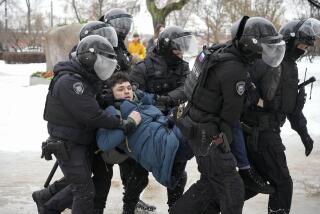‘Crony Capitalism’ Sinks a Nation’s Dreams in Debt
- Share via
MOSCOW — Doing business in high-risk Russia never worried Dmitry Silin--until this month. Then the ruble tumbled. Now his years of hard work building up a medical supplies import firm are turning to dust, and there’s nothing the bewildered entrepreneur can do but watch and wring his hands.
The $100,000 worth of rubles that Silin’s Russian clients paid him at the beginning of August is lost somewhere in a collapsing banking system. His bank says he might get some of it back “in two or three months.”
“I’m not on the edge of the abyss, I’m right down at the bottom. And I don’t think I can climb out,” said Silin, a former scientist who had eagerly embraced the new challenge of commerce after the Soviet Union collapsed in 1991.
The question tormenting this 45-year-old Muscovite--What went wrong?--is being echoed across Russia and the West, now that the much-touted achievements of seven post-Soviet years of “free market reform” are being reassessed against a gloomy new backdrop of economic and political chaos.
Ostensibly, the reforms of President Boris N. Yeltsin’s various governments--privatization, removal of price controls, foreign trade liberalization, reducing inflation--made Communist Russia capitalist.
But many analysts suggest that Russian economic reform since 1992 has all along been a conjuring trick with smoke and mirrors--what came to be known derisively as “crony capitalism.” Much discussed and much promised, the reforms never quite became reality, even though Yeltsin and his top politicians repeatedly invoked the magic formulas of capitalism.
“We haven’t ever had a liberal economic policy in Russia in the last seven years,” scoffed Andrei Illarionov, director of the Institute for Economic Analysis. “All that we have really had were different variants of a state protectionist policy. Its bankruptcy in the course of the present crisis is the bankruptcy of that state protectionist and isolationist policy.”
Boom Never Materialized
Since 1992, the International Monetary Fund, or IMF, has poured in $31.2 billion to support its standard prescriptions--for currency support, tax reform and government fiscal austerity--that aim to create a stable climate favorable to free-market enterprise. With this help, Russia’s vast natural resources and highly educated population were expected to ensure a prosperous future.
But the boom never happened. Instead, year after year, the economy has contracted, shrinking more than 40% since the collapse of communism. Now that the decline has accelerated, Russia’s outlook could scarcely be bleaker.
The ruble, “set free” 11 days ago to find its market level, was worth only half as much by midweek, and trading was halted Thursday until further notice. The stock market crumbled, and has now lost more than 80% of its value this year. The debt market, a speculative money-spinner until mid-August, has stopped existing. By freezing repayments on some debt last week--a move investors call default--Russia has alienated the West and cut off access to foreign credit.
A chaotic tax collection system means revenues are iffy. The Russian banking sector is paralyzed. Most of the banks look likely to collapse, and those that survive will do so largely because their rich “financial oligarch” bosses have influence over the incoming government of returning acting Prime Minister Viktor S. Chernomyrdin.
Indeed, the more things change, the more they remain the same.
Valuable State Assets Went to the Wealthy
Russian reform started with a privatization program in the early 1990s. The move was much praised in the West as a great leap forward toward capitalism. But, in reality, it turned into under-the-counter sales of valuable state assets at bargain basement prices to half a dozen wealthy bankers and businessmen--the oligarchs--who had cronies in government.
“Today, almost all production is nominally in private hands, and few industrial workers remain state employees. But this does not mean that the Russian economy is built on a foundation of private property or that private enterprises are really private,” wrote Michael S. Bernstam and Alvin Rabushka of the Hoover Institution in a recent book, “Fixing Russia’s Banks.”
This distorted privatization created a web of unhealthily close personal ties between state officials and entrepreneurs. Because the oligarchs’ assets, which now amount to about half the Russian economy, were acquired through a murky system of loans from the oligarchs’ banks to the state budget, the state and allegedly private businesses have been left inextricably linked.
The government would bail out its business cronies, whose firms failed to pay taxes but never went bankrupt; in return, big business bailed out unpopular politicians, notably Yeltsin by funding his reelection in 1996. The system that came into being in Russia was “crony capitalism.”
“What appear to be private firms are not really private because they share a common budget with the public sector. So-called private firms and private banks in Russia have served largely as appendages to a differently constructed system of state control and financing than was the case in the former socialist system,” Bernstam and Rabushka wrote.
Equally illusory, in the long term, was the stabilization program that got underway by the mid-1990s under Chernomyrdin.
The ruble, whose value had shrunk to almost nothing after the Soviet collapse, was traded from 1995 on in a “corridor” that allowed it to drift very gently lower. If it nudged the bottom limit of the corridor, the Central Bank would intervene to prop it up. Russians who had learned to keep their savings in dollars began, very slowly, to trust their own currency.
Inflation--which had peaked at 2,500% in 1992--slowed. The Central Bank in 1994 stopped simply printing money to finance the state budget and, instead, began issuing short-term treasury bills. Banks began to buy and trade the profitable debt paper, known as GKOs. This substituting of debt for Central Bank credits was a first step toward real stabilization.
What should have come next, according to Rory MacFarquhar, an economist at the Russian-European Center for Economic Policy, was for the government to reduce its dependence on the new GKO short-term debt market--by spreading its debt burden over a variety of different instruments with different maturity dates, by raising taxes more efficiently and, most important, by spending less and cutting its overall budget deficit.
But none of this happened. Instead, the government continued to rely for money on the GKOs it rolled over every few months, increasing them each time to pay interest due on their predecessors. Pyramid-style, the GKO market grew and grew.
Government spending remained high, with any attempts to cut Russia’s bloated bureaucratic apparatus limited to mere rhetoric.
“The Russians were letting taxation slide for political reasons,” said MacFarquhar, who was critical of what some economists regard as skewed guidance from the IMF: “The IMF kept shouting at them to improve tax collection, but what it should have been shouting about more was cutting budget spending.”
Budget Deficit Kept Growing
So the budget deficit remained big, though not unmanageable, with a debt-to-GDP ratio of 44% last year. In the boom that began after Yeltsin’s reelection in 1996, stocks soared and investor confidence in Russia’s future became strong enough that the government didn’t have to offer vast yield payouts on its GKO debt to attract buyers. Yields that had hovered around a nervous 200% just before Yeltsin’s reelection were down at 20% to 30% for much of early 1997, making the payouts manageable for the government.
Then Asia intervened. As currencies there collapsed late last year, shock waves rippled through other emerging markets, such as Russia, and investors began sending their money to safer places like the United States. At the same time, Asia’s collapse triggered a worldwide glut in oil--Russia’s most valuable export.
Quickly, to keep investors in the fold, yields on Russia’s GKOs soared again: over 50%, over 100%, and this month to nearly 200%. Paying such high interest on its debt began to cost the government dearly. Reserves dwindled.
Yeltsin fired Chernomyrdin’s government in March. The IMF dithered for months over giving an extra dose of support to keep the ruble, and the GKO market, stable.
Western investors panicked, MacFarquhar said. Feeling that Russia was now too risky, they took advantage of the IMF’s eventual decision--in July--to hand Russia $11 billion more in currency support to stampede out of the GKO market. The result was the current crisis.
“The IMF gave Russia a set of classic examples that are bound to work almost anywhere. They could have worked in Russia, provided budget policy was reformed--which it wasn’t,” said Arkady Dvorkovich of the Economic Expert Group.
“The budget deficit was not reduced, but grew. For a while, GKOs refinanced the old debts. But the outflux of dollars grew,” added Dvorkovich. “In the end, it outweighed the GKO effect and led to final collapse.”
Leadership Shuffle Doesn’t Mean Change
Nor does this week’s leadership shuffle point toward change, with executive power now back in the hands of Chernomyrdin, 60. A grandee of the old Soviet industrial aristocracy, the stolid ex-boss of energy giant Gazprom was prime minister for most of the last 5 1/2 years.
Most liberals are horrified at the reemergence of Chernomyrdin--whom they see as the cheerleader for crony capitalism and in the pocket of the oligarchs.
The favored conspiracy theory of the day in Moscow is that the political shake-up was caused by a revolt of the oligarchs against Sergei V. Kiriyenko--the 36-year-old reformist prime minister Yeltsin replaced with Chernomyrdin on Sunday--once the devaluation that began under his rule Aug. 17 started to threaten the survival of their banking empires. They wanted to reinstate a complaisant boss who would be happy to turn a blind eye, as before, to their self-enrichment.
“Fearful that their economic empires could go under, and that economic and political instability could lead to a restoration of a Communist government, the oligarchs have foisted Chernomyrdin on Yeltsin in what amounts to a political coup,” said James Hughes, senior lecturer in Russian politics at the London School of Economics and Political Science.
Suspicion has more specifically focused on oligarch Boris A. Berezovsky--who as well as being boss of the giant LogoVAZ automobile empire, the TV channels ORT and TV6, the Nezavisimaya Gazeta newspaper and Ogonyok magazine, is closely allied to Yeltsin’s younger daughter and advisor, Tatyana Dyachenko--as the likeliest of the oligarchs to have quietly orchestrated Chernomyrdin’s return.
Chernomyrdin’s first move was to announce that the banking system, however rickety, must be protected--good news for the oligarchs. And this has Russians once again talking about printing more money--the sort of inflationary prescription that causes Western experts to throw up their arms in dismay.
But it is one of the few ways left to protect the banks, insists Nikolai P. Shmelyov, an economist and deputy director of the Institute of Europe.
“It’s wrong to think of money [printing] as a disaster in itself, as long as it’s not done in excess as it was, say, in the Weimar Republic in Germany. The shortages of money at the moment have been created unrealistically, so they may need to compensate a little,” he said calmly.
Some analysts are taking a bleaker view.
“We often ask if a country can go bankrupt,” wrote Marshall Goldman, associate director of the Russian Research Center at Harvard University.
“Russia under Chernomyrdin may soon provide an answer. That would be a calamity, and not just for Russia.”
More to Read
Sign up for Essential California
The most important California stories and recommendations in your inbox every morning.
You may occasionally receive promotional content from the Los Angeles Times.










